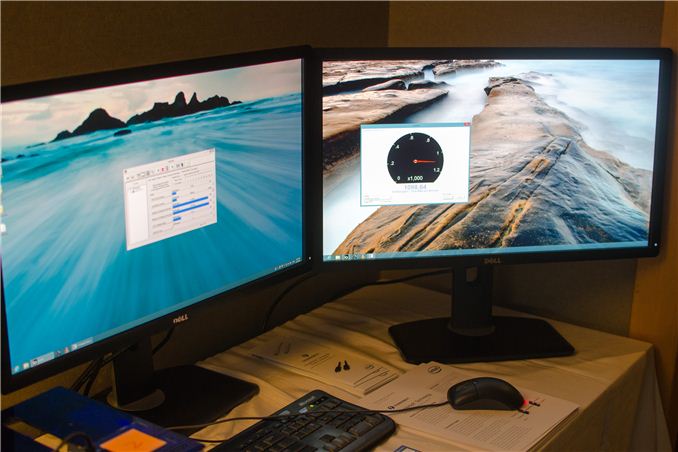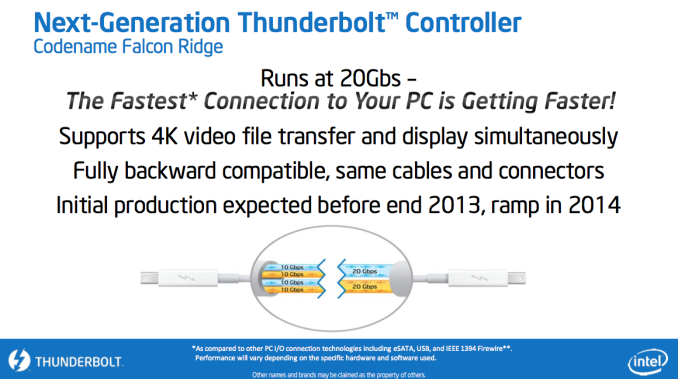Intel's Thunderbolt 2: Everything You Need to Know
by Anand Lal Shimpi on June 9, 2013 8:39 PM EST- Posted in
- Storage
- CPUs
- Intel
- Thunderbolt

At Computex, Intel officially branded its next-generation Thunderbolt as Thunderbolt 2. As a recap, current Ivy Bridge platforms use Cactus Ridge Thunderbolt controllers while newly launched Haswell platforms use Redwood Ridge. Redwood Ridge maintains feature compatibility, but you get official support for DisplayPort 1.2 (and 4K resolution) if you're using a DisplayPort monitor. This extension of DP 1.2 support does not apply to Thunderbolt displays or DP 1.2 displays connected to a Thunderbolt chain however. The explanation is simple. Redwood Ridge won't be sold for use in devices, only host computers, which is why you can't plug a 4K DP 1.2 display into a Thunderbolt chain and have it work (since none of the members of the chain will support 4K passthrough).
Falcon Ridge however is designed to address this problem later this year. Falcon Ridge will officially be the first controller to implement Thunderbolt 2. Despite the increment in nomenclature, the differences are actually pretty simple.
Today, Thunderbolt exists as four 10Gbps channels - two upstream and two downstream. Each channel however is fully independent. Although PCIe and DisplayPort are muxed from the cable perspective, you can only send one or the other over each channel. That limits max performance for a single storage device to 10Gbps (minus overhead), and it similarly limits the max display bandwidth to 10Gbps as well. The latter is insufficient for 4K video (~15Gbps depending on refresh rate). If you bypass Thunderbolt and just send DP 1.2 over the cable it's not a problem, but if you want to enable mixed use cases where you're driving both 4K video and high-speed storage over the same cable you're going to need another solution.
Thunderbolt 2 provides that solution. By combining the channels together, Thunderbolt 2 enables two 20Gbps bi-direction channels instead of two sets of 10Gbps channels. There's no overall increase in bandwidth, but the solution is now more capable. Since there's 20Gbps of bandwidth per channel, you can now do 4K video over Thunderbolt. You can also expect to see higher max transfer rates for storage. Whereas most Thunderbolt storage devices top out at 800 - 900MB/s, Thunderbolt 2 should raise that to around 1500MB/s (overhead and PCIe limits will stop you from getting anywhere near the max spec).
Intel put together a quick demo of Thunderbolt 2 silicon in one of its suites at Computex. The setup involved two Intel SSD 910s running over Thunderbolt 2 alongside two 2560 x 1440 panels. Peak performance to the SSD array was just under 1100MB/s, which Intel expects will be much higher once final hardware is ready.

The box above basically houses Falcon Ridge silicon (card on the right), connected to a board that distributes PCIe from that controller.
Thunderbolt 2/Falcon Ridge still feed off of the same x4 PCIe 2.0 interface as the previous generation designs. Backwards compatibility is also maintained with existing Thunderbolt devices since the underlying architecture doesn't really change.
I had higher hopes for what Thunderbolt 2 would be (moving to PCIe Gen 3 for example), but it looks like the spec is primarily designed around enabling 4K as well as incrementally increasing storage performance. I'm still holding out for the dramatic changes to usage models though, e.g. enabling external dGPUs over Thunderbolt, but it looks like I'll have to hold out for longer.











34 Comments
View All Comments
BMNify - Wednesday, June 12, 2013 - link
actually charlie gives a good outline herehttp://semiaccurate.com/2012/08/02/ioi-technology-...
Tesselator - Friday, August 16, 2013 - link
How do we know it's not PCIe v3 ??? He only says "it looks like...".For TB2 to be able to saturate two 20Gb/s channels it needs to either be 8 lanes of PCIe v2 or 4 lanes of PCIe v3. The language used by both Apple and Intel and a few Intel bloggers as well, indeed implies that TB2 is capable of 20Gb/s per port, two ports per controller (dedicated I/O.).
Otherwise both Intel and Apple are lying! It would be like a single controller 4-port USB3 manufacturer saying their card supports four 500MB/s connections. If that's the game then someone will likely sue them (Apple or Intel) for false advertising.
I see no indication that Anand Lal Shimpi is doing anything more than guessing.
emperius - Sunday, June 9, 2013 - link
This is all awesome and cool. I am not of those "who need this much? or "just like firewire" people. But if this chipset will be held restrictively and more BS happens across Mobo manufactures on not implementing based on overpriced licenses or something, then it will never be taken seriously. At least Apple will be using it at it's full. And I'm no Apple fanboy.danjw - Wednesday, June 12, 2013 - link
But it is daisy chain, and cables $35 for an original thunderbolt cable, not sure if those cables will work with this new version. If a device wants to let you connect more other devices down stream, it needs 2 controllers. Also, it is Intel proprietary, so I doubt they will be licencing anyone else to make the controllers. Intel insists on high margins on their products so they won't be selling controllers cheap anytime soon.BrazenRain - Sunday, June 9, 2013 - link
They should make the A-10 Warthog its mascot.danjw - Wednesday, June 12, 2013 - link
Nah, the A-10 is an awesome plane, why associate it with this joke of an interface.Zandros - Sunday, June 9, 2013 - link
Thanks for the update on the mystery that is Thunderbolt, Anand.Still, the question from the previous article remains: How does dual 2560x1440 24-bit 60 Hz displays work at the same time as other devices on Thunderbolt 1?
Also: MST hubs at the end on a Falcon Ridge chain, yes/no?
repoman27 - Monday, June 10, 2013 - link
As far as I can tell, the channels in the current versions of Thunderbolt can carry display and/or PCIe data, however this is achieved through switching between the various protocol adapters. It also seems that at any given moment, one channel per link is reserved for display, and total device bandwidth cannot exceed 10 Gbit/s.Thunderbolt 2 would appear to have a unified connection between the protocol adapters and the Thunderbolt crossbar switch. Overall though, Thunderbolt 2 is just Thunderbolt with channel bonding and full DP 1.2 support. Intel's demo used Dell displays daisy chained via DisplayPort MST at the end, so yes to that one.
This Pipeline post continues the trend of confusing as much as enlightening when discussing Thunderbolt. I believe that in Intel parlance, a link (the maximum capacity of a port or cable) is comprised of 2 independent, full-duplex channels created from 4 simplex lanes. Intel tends to refer to their controllers by the number of channels they support, hence a 2-port controller is described as 4C. Thunderbolt 2 bonds the two 10 Gbit/s channels in a link to effectively create a single 20 Gbit/s channel per link. I'm not sure if this means that 2-port Falcon Ridge controllers will be referred to as 2C.
Intel's previous demo video from NAB showed a peak of 1259.87 MB/s reading from the SSDs while driving the two displays. Since this represents more than 10 Gbit/s of both PCIe and DisplayPort packets, we can infer that the new controllers are capable of duplexing the two types of traffic. We would expect write speeds to be a bit lower (around 860 MB/s), since there isn't more than 20 Gbit/s to play with. Which makes the statement, "Peak performance to the SSD array was just under 1100MB/s," a bit suspect. Peak performance FROM the array can get that high, but not TO the array.
And I calculate the theoretical max payload throughput for PCIe 2.0 x4 with a bare minimum of protocol overhead to be 1645 MB/s... Come on, Anand. Let's see it!
wiz329 - Thursday, June 13, 2013 - link
Can the two bi-directional 20 Gb/s channels be multiplexed so that total bandwidth is 40 Gb/s for a single device?iwod - Sunday, June 9, 2013 - link
Basically there isn't any speed upgrade, total data / signal rate transfer over the cable are the same with less overhead or higher efficiency. I wonder if the 4K problem could be solved using a little bit more innovative solution instead of calling what essentially is the same thing as Thunderbolt 2.I am still waiting for the promised 50Gbps from Intel. Even though the maths doesn't add up moving from PCIe Gen 2 to Gen 3. Thunderbolt Port, Cable, Hubs, Chipset needs to be both a lot cheaper and slightly faster. I am not expecting it to compete with USB3.0 or 3.5 since they really arent the same thing.